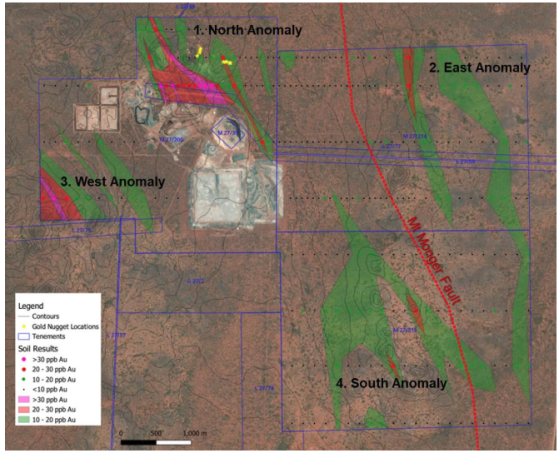Poseidon Nickel Ltd (ASX:POS, OTC:PSDNF) has further advanced its gold exploration programs at the Black Swan project in Western Australia.
THe company collected 362 soil samples from a wide-spaced reconnaissance soil sampling program over the entire Black Swan tenement package on 800-metre and 400-metre space traverses with sampling intervals of between 80 metres and 160 metres.
The soil samples were tested using the UltraFine+ technique identifying four coherent anomalies across the program.
Black Swan gold-in-soil anomalies.
The most coherent anomaly at the Wilson’s Prospect is just north of the existing Black Swan nickel mines and associated infrastructure. It is 1.4 kilometres by 1 kilometre in size and remains open to the south.
Assays up to 54ppb of gold were returned from this anomaly, which covers an area adjacent to the previously reported gold bearing rock chip samples grading up to 1.25g/t gold and the previously announced gold nugget discoveries.
Several historical gold drill intersections with assay results of greater than 1g/t of gold, including 0.4 metres at 6.41 g/t gold, are also within the anomaly area, despite only 5% of all historical drillhole samples being assayed for gold.
The company notes that the layered indicators for gold potential at Wilson’s Prospect point to a highly prospective exploration target as evaluation programs continue.
Gold potential previously overlooked
Poseidon CEO Brendan Shalders said: “During August 2024 the company completed a wide spaced reconnaissance soil sampling program across the entire landholding at Black Swan which was assayed for the full suite of elements.
“Soil sample assay results have noted four promising gold in soil anomalies. The extents of the anomalies and morphology appear to be tracing the prospective gold bearing structures throughout the geological sequence at Black Swan which have never been systematically tested for gold.
“There is little outcrop at Black Swan thus reconnaissance surface geochemical surveys are considered a cost-effective exploration technique to quickly identify areas of gold anomalism.
“Due to the significant dilution of the soil profile as it is mainly comprised of sands and clays, the gold values recorded are usually only at low levels (ppb).
“The importance of a gold in soil anomaly is it often presents a vector to a prospective gold system below, and in its original undiluted setting, maybe at much higher grades, hence drilling is required to effectively test the target.
“We are particularly excited about the gold targets that are presenting at the Wilson’s prospect. Results of the separate work programs to date are showing several positive coincident attributes underpinning the prospectivity for the targets.
“These include the establishment of a large coherent gold in soil anomaly with a footprint that captures the locations of the previously reported gold nuggets, anomalous rock chip samples and historical drilling intersections grading up to 6.41g/t gold.
“Despite the historical gold intersections, only 5% of all drillhole samples at Black Swan were assayed for gold. Given the lack of gold assays and the historical focus on nickel, the gold potential at Black Swan has been somewhat overlooked.”
Gold exploration continues
High priority infill soil and further grab sampling programs are now underway to better define soil trends at Black Swan, with the infill results to be used to optimise drill targets and progress the planning for low-cost shallow drilling programs.
At Lake Johnston, maiden reconnaissance soil surveys were completed in early September across the newly acquired Mantis tenement and submitted for analysis. Results are pending.
Once received and interpreted the company plans to continue to undertake additional programs to progress and establish any newly identified gold targets within the portfolio.
Read more on Proactive Investors AU
